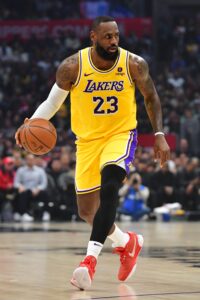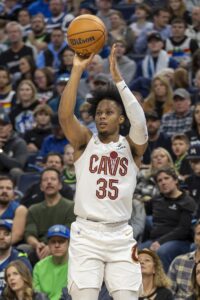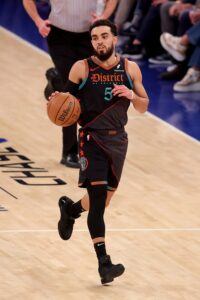As the NBA regular season approaches and teams reduce their rosters from the 21-player offseason limit to the 15-man regular season max, the best way to determine which players will survive preseason cuts is to consider their contracts. Players with guaranteed salaries for 2024/25 are far more likely to earn spots on 15-man rosters than players whose contracts aren’t fully guaranteed.
Keeping that in mind, we’re using the space below to keep tabs on the players on each NBA team who don’t have fully guaranteed contracts. The players listed here have non-guaranteed salaries, partially guaranteed salaries, or Exhibit 9 or Exhibit 10 contracts, which essentially function like non-guaranteed deals.
Unless otherwise noted, these players are on minimum-salary contracts. Some players on this list have partial guarantees, which we’ve also mentioned below.
Not all of these players will be waived before the regular season begins, so we’ll maintain this list for the next several months, up until January 10, 2025. That’s the day that all players still under contract will have their salaries fully guaranteed for the rest of the 2024/25 season.
[RELATED: Early NBA Salary Guarantee Dates For 2024/25]
Only players who have formally signed contracts are listed below, so if a player has reportedly reached an agreement with a team on a non-guaranteed deal, we’ll add him to our list when that deal becomes official and we confirm the details.
Without further ado, here’s the full list of players without fully guaranteed salaries for 2024/25, broken down by team:
Updated 9-19-24 (11:02pm CT)
Note: Players on Exhibit 10 contracts are marked with an asterisk (*).
Atlanta Hawks
Boston Celtics
Brooklyn Nets
- Keon Johnson
- Partially guaranteed for $250,000.
- Jalen Wilson
- Partially guaranteed for $75,000.
Charlotte Hornets
- Taj Gibson
- Partially guaranteed for $1,082,270.
- Marcus Garrett *
- Keyontae Johnson *
- Caleb McConnell *
- Joel Soriano *
Chicago Bulls
Cleveland Cavaliers
- Craig Porter
- Partially guaranteed for $1,000,000.
- Sam Merrill
- Tristan Thompson
Dallas Mavericks
Denver Nuggets
Detroit Pistons
- Paul Reed ($7,723,000)
- Javante McCoy *
- Tolu Smith *
Golden State Warriors
Houston Rockets
Indiana Pacers
- James Johnson
- Partially guaranteed for $750,000.
- James Wiseman
- Partially guaranteed for $500,000.
- Kendall Brown
- Cole Swider
Los Angeles Clippers
Los Angeles Lakers
Memphis Grizzlies
Miami Heat
Milwaukee Bucks
- Andre Jackson
- Partially guaranteed for $945,929.
- James Akinjo *
- Philip Alston *
- Liam Robbins *
Minnesota Timberwolves
- PJ Dozier
- Partially guaranteed for $1,000,000.
- Jaedon LeDee *
- Skylar Mays *
- Eugene Omoruyi *
New Orleans Pelicans
New York Knicks
- Jericho Sims
- Partially guaranteed for $1,302,359.
- Marcus Morris
- Landry Shamet
- Chuma Okeke *
Oklahoma City Thunder
Orlando Magic
Philadelphia 76ers
Phoenix Suns
- None
Portland Trail Blazers
- Dalano Banton
- Partially guaranteed for $217,533.
- Devonte’ Graham
- Henri Drell *
Sacramento Kings
- Orlando Robinson
- Partially guaranteed for $500,000.
- Keon Ellis
- Boogie Ellis *

 [RELATED:
[RELATED:  There are still a couple teams with cap room available, so one of those teams – the Pistons and Jazz – could make life difficult for the Cavaliers by giving Okoro an offer sheet in that $12-15MM range, but there has been no indication either club plans to do so. A sign-and-trade to an over-the-cap team is another possibility, and Fedor confirmed in
There are still a couple teams with cap room available, so one of those teams – the Pistons and Jazz – could make life difficult for the Cavaliers by giving Okoro an offer sheet in that $12-15MM range, but there has been no indication either club plans to do so. A sign-and-trade to an over-the-cap team is another possibility, and Fedor confirmed in 
 As the Wizards’ starting point guard, Jones established new career highs in field goal percentage (48.9%), three-point percentage (41.4%), points per game (12.0), and assists per game (7.3) while continuing to protect the ball better than just about anyone in the league. His 1.0 turnover per game in ’23/24 represented the worst mark of his career.
As the Wizards’ starting point guard, Jones established new career highs in field goal percentage (48.9%), three-point percentage (41.4%), points per game (12.0), and assists per game (7.3) while continuing to protect the ball better than just about anyone in the league. His 1.0 turnover per game in ’23/24 represented the worst mark of his career.